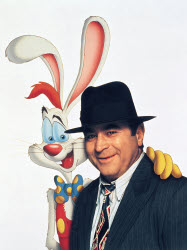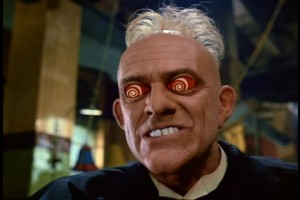I was saddened to hear of the passing of actor Bob Hoskins, who was fantastic in the 1988 blockbuster “Who Framed Roger Rabbit?” The movie was one of my all-time favorites, but unfortunately the fictional plot propogated false conspiracy theories about the demise of LA’s old streetcar rail network. For those who haven’t seen it (spoiler alert), the villain in the movie, Judge Doom (played by Christopher Lloyd), buys up the Pacific Electric streetcar network in Los Angeles to convert it to freeways. I vividly remember watching it in the theater and hearing the audience laugh heartily at this dialogue:
Judge Doom: A few weeks ago I had the good providence to stumble upon a plan of the city council. A construction plan of epic proportions. We’re calling it a freeway.
Eddie Valiant: Freeway? What the hell’s a freeway?
Judge Doom: Eight lanes of shimmering cement running from here to Pasadena. Smooth, safe, fast. Traffic jams will be a thing of the past.
To this day, when I tell people about Railtown, my book on LA’s rail history, they frequently ask me about the conspiracy theory that car companies deliberately destroyed Los Angeles’ once-great streetcar network, and they often mention Roger Rabbit. One transit agency veteran whom I interviewed for Railtown, Richard Stanger, told me that he credits the film with helping to motivate voters to approve Proposition C, the 1990 sales tax measure that dedicated new funds for rail expansion.
The problem is that the conspiracy theory about the demise of rail transit in LA is wrong. As Martin Wachs and other scholars have documented, the Pacific Electric system of the past was not all it was cracked up to be, and like many cities around the country, it fell victim to the widespread popularity of the automobile.
LA, like other cities in the late nineteenth century, took advantage of electric streetcar technology to expand its reach outside of the commercial core. But when the car was introduced, Angelenos took to the technology en masse. Because Los Angeles had a much smaller population at the time, the car represented freedom to go anywhere quickly. The streetcars, by contrast, were slow, expensive, and unpleasant. They began to lose money, and the public refused to step in and rescue them. This story happened in cities all over the United States at the time.
Then in 1974, along came Bradford Snell, a young government attorney who testified that General Motors and other auto interests bought up the Pacific Electric lines to destroy them and force people to buy cars. As Cliff Slater documented, however, UCLA transportation scholars like Wachs and George Hilton and a number of respected journalists (including the pro-rail New Electric Railway Journal) comprehensively refuted these claims at the time.
But Snell’s charges caught the public imagination and have been repeated by some elected officials ever since. The Roger Rabbit movie further popularized the theory.
So while we mourn the passing of Hoskins and celebrate the fun of “Who Framed Roger Rabbit?”, let’s put to rest this conspiracy idea. It does not help solve the traffic and environmental problems of today, and by discounting the popularity of the automobile and what the technology represents to many people, it undercuts sensible strategies to convince people to take transit, walk, or bike over driving. But more importantly, the theory is just wrong.
Let’s let it rest in peace, along with Mr. Hoskins.




